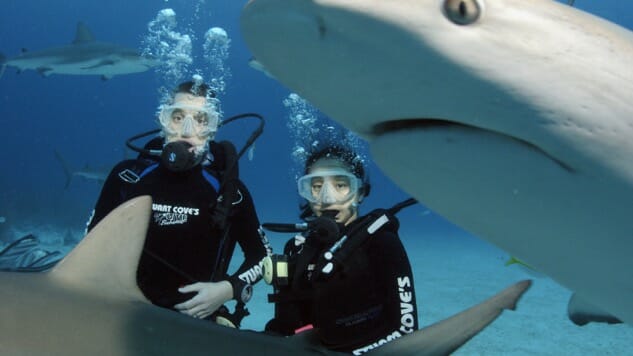deGeneration X: Swimming with Sharks off Sipadan Island

The movie Jaws traumatized me a young boy in the 1970s. Now as an adult, it was time to face my fears, but how many sharks are too many? I was about to find out.
It took me long enough, but I finally got my PADI dive certification at age 39 in Taganga, Colombia, and I intended to make full use of it when I visited Southeast Asia five months later. I dove off Koh Tao in Thailand and swam with manta rays off the Gili Islands in Indonesia, but all these underwater adventures were mere warm-ups to the big event in the shark-infested waters around Sipadan Island. I previously swam with sharks in the Galapagos Islands in Ecuador and Fernando de Noronha in Brazil, but those predators looked like minnows next to the giants roaming the Celebes Sea off Malaysian Borneo.
Sipadan, a 30-acre oceanic island in the Indo-Pacific basin, formed over thousands of years from living corals growing atop an extinct volcanic cone. Under the water, the island resembles a giant rock column shooting up nearly 2,000 feet from the seabed below. Many of the shear walls sit only 50 feet from the shore, creating stellar dive spots like the appropriately named Drop Off. The dozen or so main dive spots reportedly contain about 3,000 fish species and hundreds of coral species, but most people come to see the big fish, e.g., sharks, turtles and rays. Covered in rainforest, Sipadan became a bird sanctuary under British colonial rule, but today’s main attraction is what swims below the shore, not what soars above it.
“I have seen other places like Sipadan, 45 years ago, but now no more,” said legendary oceanographer Jacques Cousteau in the 1989 documentary Borneo: The Ghost of the Sea Turtle. “Now we have found an untouched piece of art.”
Sipadan previously housed a few resorts, but they were relocated to nearby Mabul Island about a decade ago to protect the fragile ecosystem. A third spot is Kapalai Island—a small sandbank atop the Ligitan Reef—which houses some divers in a resort made up of little cabins on stilts above the water. The government limits Sipadan dive permits to 120 per day, and each dive company receives a certain number. I contacted various operators about a month before my proposed visit, and many were out of permits, while others required a dive in Mabul for each dive in Sipadan. I finally connected with Uncle Chang’s Backpackers Resort, a lower-cost operator with hostel-like facilities on Mabul, that still had permits available. I booked six dives over two days entirely around Sipadan.
Coming in from Bali, Indonesia, I arrived late in Semporna, a city on the eastern edge of Sabah state, and a 30-minute boat ride to Mabul left a 7:30 a.m. the next morning. Upon arrival, I quickly stowed my stuff and started to get ready. I would be diving that day.
“You’re going to see a bunch of turtles this morning” explained the dive master as the boat sped to our first dive spot.
We spent the first day northwest of the island at Turtle Cave, Drop Off and Barracuda Point. When I first dropped into the turquoise-colored water, I quickly gazed about, and it looked like I’d jumped straight into a fish tank.
Cousteau made Sipadan famous nearly 30 years ago with his documentary on the local sea turtles, and many large green and hawksbill turtles live and mate in the waters around the island. Expert divers can experience Turtle Cave (or Tomb), a limestone cave system about 70 feet down that contains skeletons of drowned turtles who lost their way inside. Sea turtles are an endangered species around the world, but these are some of the few waters in which they can be found in abundance.
As we explored the turtle-rich waters, we saw our fair share of sharks. Whale sharks, scalloped hammerhead sharks and manta rays reportedly visit the waters around the island, but our dive group mostly saw eagle rays and oversized reef sharks. During the second dive at Barracuda Point, however, I experienced a sight that made me completely forget about sharks.
Navigating the waters around Barracuda Point, my dive partner hit me on the shoulder and pointed ahead to an underwater mountain peak that stopped about 10 feet from the surface. All the divers from all the groups headed in that direction, and we followed. As we got closer, I looked through the greenish-blue waters in disbelief at what I had thought was a mountain. Before us, seemingly thousands of barracuda were swimming in circles creating a giant vortex maybe 50 feet high. The mountain transformed into a barracuda tornado, and our group spent the rest of the dive time fixated on this remarkable sight.
-

-

-

-

-

-

-

-

-

-

-

-

-

-

-

-

-

-

-

-

-

-

-

-

-

-

-

-

-

-

-

-

-

-

-

-

-

-

-

-








































